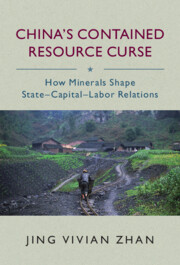Book contents
- China’s Contained Resource Curse
- China’s Contained Resource Curse
- Copyright page
- Dedication
- Contents
- Figures
- Tables
- Acknowledgments
- Abbreviations
- 1 Minerals and the State–Capital–Labor Triad
- 2 Minerals, Capital, and Local Economic Development
- 3 Resource Extraction and Victimization of Labor
- 4 Resources and Local State Capture
- 5 Resources and Local Public Goods Provision
- 6 Coping with the Resource Curse
- References
- Index
3 - Resource Extraction and Victimization of Labor
Published online by Cambridge University Press: 24 March 2022
- China’s Contained Resource Curse
- China’s Contained Resource Curse
- Copyright page
- Dedication
- Contents
- Figures
- Tables
- Acknowledgments
- Abbreviations
- 1 Minerals and the State–Capital–Labor Triad
- 2 Minerals, Capital, and Local Economic Development
- 3 Resource Extraction and Victimization of Labor
- 4 Resources and Local State Capture
- 5 Resources and Local Public Goods Provision
- 6 Coping with the Resource Curse
- References
- Index
Summary
In contrast to the benefits that capital enjoys, Chapter 3 shows in detail the largely negative impacts of mineral extraction on labor. Based on qualitative evidence on the working conditions and employment opportunties in mining industries, it reveals that resource boom in general does not benefit common citizens as the labor force. Moreover, mining industries generate various negative externalities to local communities, which impose heavy financial and health costs on local citizens. Statistical analysis corroborates the empirical observations and shows that resource abundance diminishes employment opportunities in not only high-tech but also labor-intensive industrial sectors and represses labor income in both urban and rural areas. The findings suggest that the resource sector can be characterized as pro-capital and anti-labor, which generates profound implications for social equality and stability.
Keywords
- Type
- Chapter
- Information
- China's Contained Resource CurseHow Minerals Shape State Capital Labor Relations, pp. 76 - 113Publisher: Cambridge University PressPrint publication year: 2022

